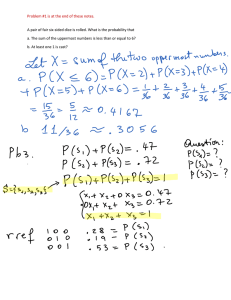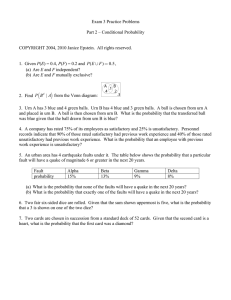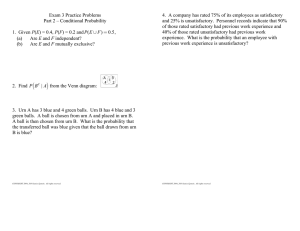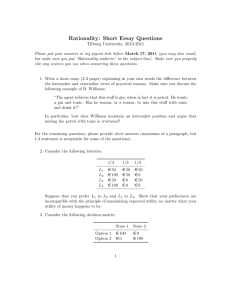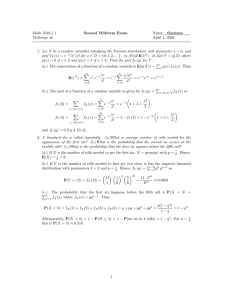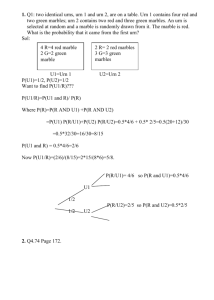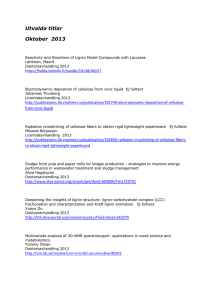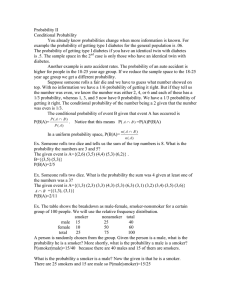Math 141 WIR8_Dr. Rosanna Pearlstein 1.
advertisement
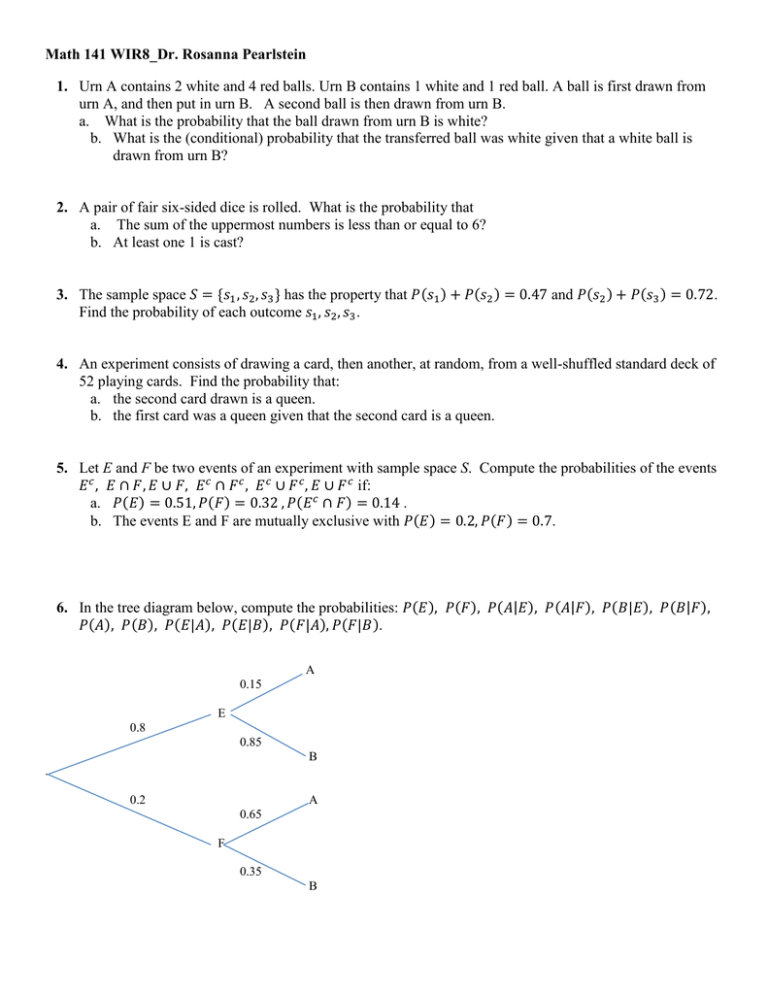
Math 141 WIR8_Dr. Rosanna Pearlstein
1. Urn A contains 2 white and 4 red balls. Urn B contains 1 white and 1 red ball. A ball is first drawn from
urn A, and then put in urn B. A second ball is then drawn from urn B.
a. What is the probability that the ball drawn from urn B is white?
b. What is the (conditional) probability that the transferred ball was white given that a white ball is
drawn from urn B?
2. A pair of fair six-sided dice is rolled. What is the probability that
a. The sum of the uppermost numbers is less than or equal to 6?
b. At least one 1 is cast?
3. The sample space 𝑆 = {𝑠1 , 𝑠2 , 𝑠3 } has the property that 𝑃(𝑠1 ) + 𝑃(𝑠2 ) = 0.47 and 𝑃(𝑠2 ) + 𝑃(𝑠3 ) = 0.72.
Find the probability of each outcome 𝑠1 , 𝑠2 , 𝑠3 .
4. An experiment consists of drawing a card, then another, at random, from a well-shuffled standard deck of
52 playing cards. Find the probability that:
a. the second card drawn is a queen.
b. the first card was a queen given that the second card is a queen.
5. Let E and F be two events of an experiment with sample space S. Compute the probabilities of the events
𝐸 𝑐 , 𝐸 ∩ 𝐹, 𝐸 ∪ 𝐹, 𝐸 𝑐 ∩ 𝐹 𝑐 , 𝐸 𝑐 ∪ 𝐹 𝑐 , 𝐸 ∪ 𝐹 𝑐 if:
a. 𝑃(𝐸) = 0.51, 𝑃(𝐹) = 0.32 , 𝑃(𝐸 𝑐 ∩ 𝐹) = 0.14 .
b. The events E and F are mutually exclusive with 𝑃(𝐸) = 0.2, 𝑃(𝐹) = 0.7.
6. In the tree diagram below, compute the probabilities: 𝑃(𝐸), 𝑃(𝐹), 𝑃(𝐴|𝐸), 𝑃(𝐴|𝐹), 𝑃(𝐵|𝐸), 𝑃(𝐵|𝐹),
𝑃(𝐴), 𝑃(𝐵), 𝑃(𝐸|𝐴), 𝑃(𝐸|𝐵), 𝑃(𝐹|𝐴), 𝑃(𝐹|𝐵).
A
0.15
E
0.8
0.85
B
.
0.2
A
0.65
F
0.35
B
7.
(From Durbin et.al. "Biological Sequence Analysis", Cambridge University Press, 1998) A rare
genetic disease is discovered. Although only one in a million people carry it, you consider getting
screened. You are told that the genetic test is extremely good; it is 100% sensitive (it is always correct if
you have the disease) and 99.99% specific (it gives a false positive result only 0.01% of the time). Having
recently learned Bayes' theorem, you decide not to take the test. Why?
8. On the basis of data obtained from the National Institute of dental Research, it has been determined that
42% of 12-year-olds have never had a cavity, 34% of 13-year-olds have never had a cavity, and 28% of
14-year-olds have never had a cavity. Suppose a child is selected at random from a group of 24 junior
high school students that includes six 12-year-olds, eight 13-year-olds, and ten 14-year-olds. If this child
does not have a cavity, what is the probability that this child is 14 years old?
9. A survey conducted by an independent agency for the National Lung Society found that of 2000 women,
680 were heavy smokers and 50 had emphysema. Of those who had emphysema, 42 were also heavy
smokers. Using the data in this survey, determine whether the events “being a heavy smoker” and “having
emphysema” are independent events.
10. The Acrosonic model F loudspeaker system has four loudspeaker components: a woofer, a midrange, a
tweeter, and an electrical crossover. The quality-control manager of Acrosonic has determined that on the
average 1% of the woofers, 0.8% of the midranges, and .5% of the tweeters are defective, while 1.5% of
the electrical crossovers are defective. Determine the probability that a loudspeaker system selected at
random coming off the assembly line and before final inspection is not defective. Assume that the defects
in the manufacturing of the components are unrelated.
11. A company surveyed 1000 people on their age and the number of jeans purchased annually. The results of
the poll are shown in the table below.
Jeans
Purchased 0
Annually
Under 12
0
12-18
21
19-25
40
Over 25
73
Total
134
3 or
more
Total
77
70 63
50 147 52
54 126 40
64
96 27
245 439 182
210
270
260
260
1000
1
2
Find the probability that:
a) The person is over 25 and purchases 3 or more jeans
annually.
b) The person is older than 18 or purchases 1 pair of jeans
annually.
c) The person is in the age group 12-18 and purchases at
most 2 pairs of jeans annually.
